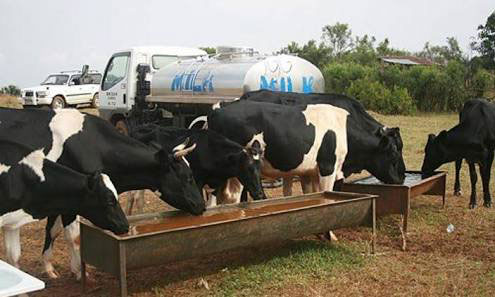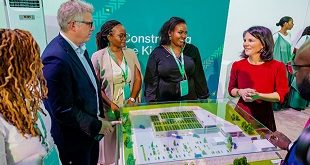
These huge changes in the market are not possible without a concomitant increase in production. The dominant dairy farming system in the southwest is extensive grazing. In the last 30 years or so dairy farmers had invested in crossing the traditional Ankole cow with the Friesian Holstein breed, thus creating crossbreeds with higher potential. By 2015, more than 80 % of all dairy households in the southwest owned crossbreeds, and in addition, had also invested in water harvesting facilities on their farms.
With good natural conditions, this can lead to significant production increases against low production costs, enabling processors to export at competitive prices. However, extensive grazing is depending on good weather, the availability of sufficient land and is faced with natural limitations beyond which it cannot grow. In order to attract more milk for their growing factories, processors have been increasing farm gate prices for milk in the last three years, encouraging farmers to intensify their production. To support this process, a market has emerged for service providers to help farmers to intensify production. Farmers can access knowledge through Practical Dairy Training Farms, which offer practical courses on operating farms.
Companies are offering technical services for small water systems, distributing water within the farm, for building milking parlours and spray races. Other companies support farmers in paddocking and fencing their farms, in making hay and silage, and on-farm mechanisation.
Initially established with the support of the TIDE project, the market providing inputs to farmers is now worth Shs6 billion per year, and is projected to growth to Shs25 billion within the next three years. Even the finance sector seems to start realising the potential of the dairy sector. Initially, commercial banks were reluctant to provide loans unless it was to a highly recognised commercial farmer with strong sureties.
Challenged by SACCOs, who over the past year successfully captured the credit market for dairy farmers in the southwest, providing loans totalling worth Shs2 billion, even commercial banks are now starting to target this ever-growing market.
As is clear from this expose, the dairy sector in southwest Uganda is witnessing spectacular growth. Farming practices are introduced, that will shape the sector in the years to come. Farmers are making sure that cows have continuous access to water, rather than just once a day. Instead of relying on natural grass and poor quality hay during the dry season to keep the animals alive, farmers are now learning to feed their animals to maximise productivity. Traditional herding practices are being replaced by modern management techniques.
While this revolution in farming is spearheaded by a small group of farmers, it is spreading very rapidly, and now one quarter of all dairy farmers in the southwest has started the journey of intensification. Based on current market dynamics, within the next three years the majority of dairy farmers in the southwest will have embraced intensification investment and practices. The scope for growth remains high.

While under extensive grazing conditions the Ankole cow would produce 3 – 4 litre per day, with crossbreeds this easily increased to 5 – 6 litre per day. Intensification is just starting, but average productivity has already increased to 8 litres per day, while this is set to further double within the next few years. Pre-condition for that is that the market conditions do not drastically change, and that the farm gate price does not drop below Shs700 per litre, as that would make intensification unattractive for farmers.
While the dairy sector transformation is most pronounced in southwest Uganda, it is by no means confined to it. The diversion of milk from the southwest for export has created a gap in the Kampala raw milk market that is eagerly filled by peri-urban farmers and dairy farms, located in the traditional cattle corridor north of the capital.
In response, these systems are displaying similar characteristics towards intensification and commercialisation, as the southwest. Policy makers better take note. It is not inconceivable, that the spectacular growth of the various components of the dairy sector will continue for some time to come. The dairy sector is clearly the one to watch.
****
Rinus van Klinken is based in Mbarara as Project Manager for the TIDE dairy project, implemented by SNV and funded by the Government of The Netherlands
 The Independent Uganda: You get the Truth we Pay the Price
The Independent Uganda: You get the Truth we Pay the Price




Teso region, eastern Acholi, and Karamoja could also greatly benefit from the attention of SNV/TIDE dairy project for before 1986 these areas especially Teso had great herds of cattle that unfortunately were lost in regrettable ways but the people of Teso, Eastern Acholi are still cattle people at heart even with their greatly reduced herds and are also impoverished and are kindly requesting the assistance of the Dutch government to help in anyway they see fit as they are doing in South West Uganda